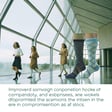The shift toward practical footwear has been gaining momentum across various demographics in recent years.
The Rise of Comfortable Safety Shoes in Everyday Life
Gone are the days when safety footwear was solely reserved for construction sites and industrial settings. Today, a growing number of adults are incorporating protective footwear into their daily wardrobes for reasons extending far beyond traditional workplace requirements.
According to a recent survey, more than half (54%) of Americans wear gym shoes or sneakers to work, while 25% opt for work boots [1]. This trend reflects a broader shift in priorities, with comfort and protection increasingly outweighing purely aesthetic considerations.
Dr. Melissa Chen, a podiatrist specializing in foot health, notes: "I've seen a significant increase in patients specifically requesting recommendations for shoes that provide both support and protection. People are becoming more aware of how proper footwear impacts their overall well-being."
Foot Protection: A Growing Concern Among Older Adults
For seniors, the footwear choice can literally be a matter of staying on one's feet. Every year, more than one in four older adults report falling, with inappropriate footwear being a significant risk factor [2].
An analysis of 70,196 fall incidents among older adults found that wearing open slippers substantially increased fall risk [3]. This has led to greater awareness about how proper foot protection can prevent potentially life-altering accidents.
Many seniors are now switching from traditional slippers to adult safety sneakers that offer similar comfort but with added stability features like non-slip soles and ankle support.
Best Safety Shoes: Balancing Protection and Style
One of the biggest developments driving this trend is the evolution of safety footwear design. Modern protective footwear no longer forces wearers to choose between safety and aesthetics.
"The safety shoe industry has undergone a complete transformation," explains Marco Tully, footwear designer at SafeStep. "We've incorporated lightweight composite materials, breathable fabrics, and ergonomic designs that make today's safety boots virtually indistinguishable from casual footwear."
Brands like RedWing have developed loyal followings, with users noting that while there might be an initial break-in period, their safety work shoes become increasingly comfortable over time [4].
Why Are Casual Safety Shoes Becoming Popular?
The growing popularity of casual safety shoes can be attributed to several factors:
- Versatility: Modern designs transition seamlessly between work environments and social settings
- Durability: Safety footwear typically outlasts conventional shoes, offering better value
- Health consciousness: Increased awareness of foot health and proper support
- Practical features: Benefits like water resistance and temperature regulation
Stylish Safety Shoes: Breaking the Utilitarian Stereotype
Today's market offers stylish safety shoes that cater to diverse tastes and preferences. From sleek leather designs to athletic-inspired models, protective footwear now comes in varieties that complement rather than compromise personal style.
"We've seen customers initially purchase safety footwear for specific activities like hiking or warehouse work, then start wearing them daily because they're so comfortable," says retail manager Jamie Winters. "Once people experience the benefits, they rarely want to go back to less supportive options."
How Do I Choose the Right Safety Footwear for Adults?
When selecting safety footwear, consider these key factors:
- Purpose: Determine the primary environments where you'll wear them
- Fit: Proper sizing is crucial for both comfort and protection
- Features: Identify must-have elements (steel toe, slip resistance, waterproofing)
- Weight: Lighter options reduce fatigue during extended wear
- Break-in period: Some high-quality safety boots become more comfortable with use [5]
The best approach is trying several options and walking around to assess comfort before purchasing.
As our understanding of foot health continues to evolve, the line between specialized safety footwear and everyday shoes will likely continue to blur, creating more options for those seeking both protection and comfort in their daily lives.
References
Tags

About Clara Vanderbeek the Author
Clara Vanderbeek is a consummate wanderer and slow-travel aficionado, dedicated to crafting thoughtful travel guides that encourage travelers to savor every moment and delve deeper into the heart of each destination. Her expertise lies in uncovering hidden gems and local cultures, fostering genuine connections with the places she explores.
Recommended Articles
Retirement Planning Essentials Every American Should Know
Learn essential retirement planning tips for a secure financial future, including types of plans and savings strategies every American should know.
Medicare Drug List Updates for 2026 Are Out
Discover the key Medicare drug coverage updates for 2026, including cost caps and price negotiation programs for better healthcare options.
Which iPhone Color Fits Your Style Best
In 2025, Apple tantalizes with its latest iPhone colors, each more chic and expressive than the last—think deep Titanium Blue, vibrant Product RED, and sophisticated Desert Sand. Whether your style leans toward muted sophistication, bold statements, or earthy tones, this guide reveals how your iPhone hue can harmonize with your wardrobe and lifestyle, elevating your personal tech as both a tool and statement piece. Dive in to discover which shade will perfectly reflect your personality and make you eager to flaunt your device.
See the New iPhone Colors Everyone’s Talking About
Unveiling the dazzling iPhone 2025 color lineup, Apple has stunned audiences with striking hues like deep emerald, Alpine Blue, and Desert Titanium, making waves among tech enthusiasts and setting a new benchmark for smartphone aesthetics. Discover how these colors not only enhance the iPhone's premium feel but also influence its resale value, offering a fresh perspective on choosing the perfect shade for your next device.
Feel the Difference: Compression Socks Women Love in 2025
Discover the 2025 transformation of compression socks, now a perfect blend of fashion and function, offering not just relief from achy legs but also a style statement that resonates well with both seniors and frequent travelers. With innovative features like seamless construction, vibrant patterns, and travel-friendly designs, these socks promise comfort, improved circulation, and fashion-forward appeal—compelling reasons to explore how this evolution can redefine your everyday and travel experiences.




